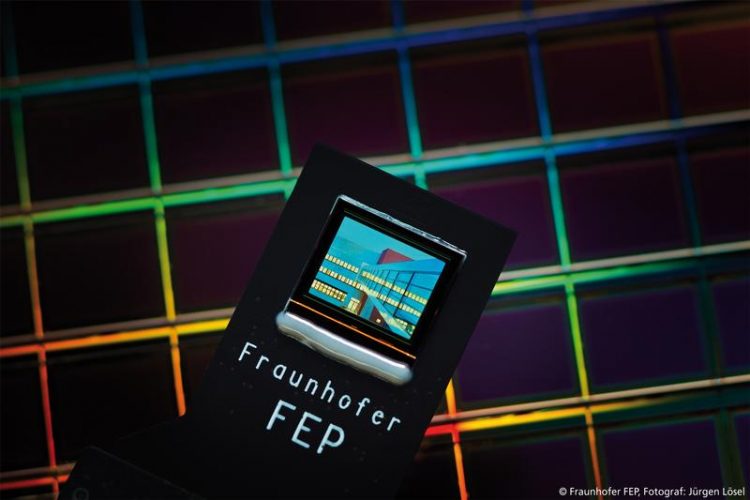Videos Controlled by Eye Movement – New Generation of Microdisplays

Bidirectional microdisplay Fraunhofer FEP
The world of the so-called wearables is colorful and versatile: Wrist band measuring the pulse, buttons, which indicate the receipt of e-mails with color change or glasses providing information about the environment.
Already in 2012, Fraunhofer FEP presented a pair of glasses which enables a normal perception of the environment and, at the same time, offers the possibility to get digital information projected directly into the user’s field of view, which can even be controlled by eye movement.
Thus, for example a technician is able to read a manual while working and scroll pages with his/her eyes without interrupting activities. This is possible with a so-called bidirectional OLED microdisplay, which is a display element that includes an embedded image sensor. The sensor can record the user’s eye movement with this integrated camera and thus enables an interaction with the displayed information.
A full-color OLED microdisplay has now been developed by the scientist where the display as well as the integrated camera functions have SVGA resolution (800 × 600 × RGBW).
Bernd Richter, Head of Department “IC and System Design”, where the new display has been developed, describes the new features: “The new generation of bidirectional microdisplays represents a quantum leap in many ways. All essential key parameters of the chip could be improved significantly.
This includes an increased resolution of the display and the image sensor as well as an enhanced color depth and the integration of further important components directly into the microdisplay chip. Following this the microdisplay can be operated with significantly fewer external components and thus contributes to further development of miniaturized and efficient systems.”
To ease customers the entry in these new technology the scientists offer development kits in various configurations. The new microdisplay can be transferred directly into product-specific applications. Moreover, fast and cost-efficient customer-specific adaptations and further developments towards innovative microdisplays are possible, which are based on an efficient design methodology of the Si-CMOS backplane circuit.
A part of the work was financed by the Federal Ministry of Education and Research (BMBF) (project ISEMO, funding code: 16SV3682) and by the Fraunhofer-Gesellschaft.
Press contact:
Mrs. Annett Arnold
Fraunhofer Institute for Organic Electronics, Electron Beam and Plasma Technology FEP | Phone +49 351 2586 452 | Annett.Arnold@fep.fraunhofer.de
Winterbergstraße 28 | 01277 Dresden | Germany | www.fep.fraunhofer.de
Media Contact
All latest news from the category: Trade Fair News
Newest articles

Parallel Paths: Understanding Malaria Resistance in Chimpanzees and Humans
The closest relatives of humans adapt genetically to habitats and infections Survival of the Fittest: Genetic Adaptations Uncovered in Chimpanzees Görlitz, 10.01.2025. Chimpanzees have genetic adaptations that help them survive…

You are What You Eat—Stanford Study Links Fiber to Anti-Cancer Gene Modulation
The Fiber Gap: A Growing Concern in American Diets Fiber is well known to be an important part of a healthy diet, yet less than 10% of Americans eat the minimum recommended…

Trust Your Gut—RNA-Protein Discovery for Better Immunity
HIRI researchers uncover control mechanisms of polysaccharide utilization in Bacteroides thetaiotaomicron. Researchers at the Helmholtz Institute for RNA-based Infection Research (HIRI) and the Julius-Maximilians-Universität (JMU) in Würzburg have identified a…



